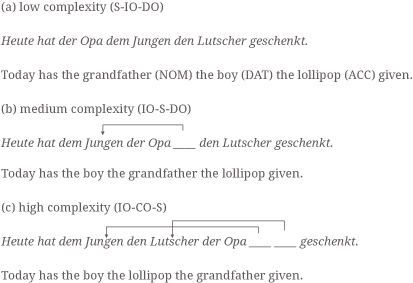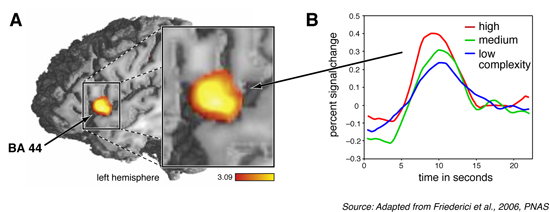Processing syntactic complexity
English is a language with a relative fixed word order. Free word order languages such as German and Japanese, different from English, is that case marking indicates whether a noun phrase is the subject or the object in a sentence. In these languages, an object-noun can change its position in the sentence (object-before-subject) and is still grammatical.
A study using German as the experimental language investigated syntactic complexity Scrambling by parametrically varying the number of permutations in a sentence (Friederici et al., 2006b). Object noun phrases (indirect object = IO, direct object = DO) were positioned in front of the subject noun (S) as in sentences (b) to (c), leading to an increase in syntactic complexity. The permutation of the noun phrase in such sentences is called “Scrambling”. (Nominative case = NOM, dative case = DAT and accusative case = ACC).
Sentences (a) to (b) are taken from Friederici et al., 2006b and displayed as in Friederici (2011).

Figure 7 indicates that the brain activation in BA 44 as part of Broca’s area increased systematically as the syntactic complexity increased.
In sum, this study and other studies (Makuuchi et al., 2009; Santi & Grodzinsky, 2010) indicate that the comprehension of syntactically complex sentences recruits Broca’s area.

Figure 7: Syntactic complexity effect in the IFG
Activation in Broca’s area (BA 44) increases systematically as the syntactic complexity of the structure of scrambled sentences increases. Plotted are the results of a region of interest analysis for BA 44. A: activation location. B: activation over time for low, medium and highly complex sentences. Figure legend is taken from Friederici, 2011 (Physiological Reviews, 91(4), 1357-1392).